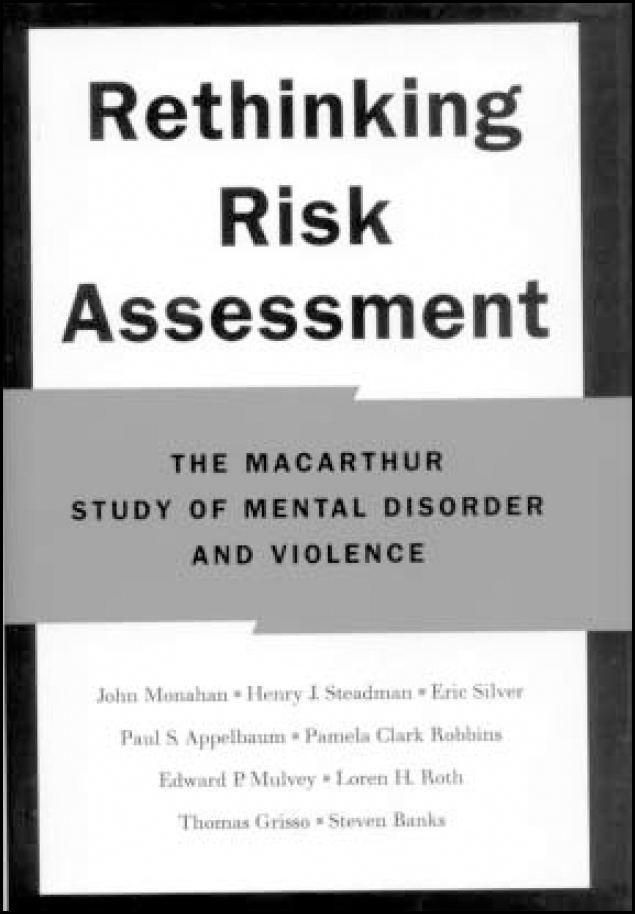
Over-funded, over-hyped, and over there. It is impossible for a British psychiatrist to look at the MacArthur study without a twinge, if not a spasm, of envy. There are many reasons - 8 million to be specific, that being the dollar cost of this epic. I mean to say, in England, that sort of money could buy you half a dozen homicide inquiries, two Fallon reports or half of a new wall around Broadmoor. Oh well. The freedom to choose how we spend our money is one of the benefits of living in a democracy. Whoever we blame for our choice of priorities, it should not be John Monahan and colleagues.
So, put aside envy and look at how they spent their cash. At first sight, 8 million dollars does not seem to buy muchresearch. The study is a12-month follow-up of around a thousand patients discharged from general psychiatric hospitals in three US cities. Spending $8,000 per subject is good going even for biological studies, where one expects to get serious technology for that kind of outlay. But there is serious technology on display here too, even though it is not in the form of chemicals or machines. The money and effort have gone into the measurement of behaviour, with semistructured interviews before discharge, followed by interviews in the community every 10 weeks. A range of standardised instruments are employed, some developed for the study. Patient interviews are supplemented by the use of informants and official records; one can't have all that effort undermined by someone suggesting the self-report was all lies. The good news is that the self-report does well, picking up far more violence than official records.
There are few studies of outcome in psychiatry, and fewer still that mention violence. This is one of the few academic publications that will make, and deserves to make, money. Buyers will end up wiser, but they will be disappointed if they expect to read the last word on violence by psychiatric patients. The reservations arise from asking why psychiatrists should be interested in violence. The simple answer is that violence is a complication of some mental disorders, but that does not make all violence equally fascinating. Patients have just as much right to get drunk and hit each other as do people without psychiatric disorders.
The central message of this study is that, for much of the time, patients behave like their friends and neighbours, so far as hitting other people is concerned. Assaults were common, committed by nearly 30% of patients over the year, but less than 10% of the assaults occurred when a patient was psychotic. Once substance misuse was excluded, patients did not have increased rates of violence and their violence followed the normal rules. The best single predictor of violence was personality disorder in the sense of psychopathy, as measured by the Psychopathy Checklist (PCL-R). Violence was also linked to alcohol, to previous violence and to neighbourhood context. This is all good news in the propaganda war between psychiatrists and politicians, but it does not help us with those rare and serious assaults that occur as a direct result of mental disorder. It will not help us to avoid a homicide inquiry. The authors produce a decision tree that classifies their patients efficiently as high or low risk, but the real test is whether it works as well with other groups of patients. Even then, it is unlikely to help us predict the rare, extreme violence that has caused so many problems for British psychiatry.
My personal gripe arises from the authors' claim that delusions were not important in predicting violence. The study is not designed to answer questions about delusions, partly because of the case mix. The more patients without psychosis there are in the sample, the less likely it is to reveal any association between violence and delusions. And what about those patients with psychosis who did not get into the sample because they were labelled as forensic cases? The presence of worrying delusions leads clinicians to assume that a patient is dangerous, thereby introducing systematic bias. A better design would have been to follow a cohort of patients with psychosis, describing how violence and delusions change over time.
The moral is that large-scale statistical studies are not the best way to investigate rare but catastrophic events. It may be heresy in a world where epidemiology is so grossly overvalued, but one can learn more about such events from a careful study of one man (provided it is the right man) than from a survey of thousands. Skinner and his behaviourists had a point when they claimed that the starting point for the study of behaviour is one pigeon, rather than a flock.
My only other criticism is the modest attention given to treatment. The study group was defined entirely by their status as patients and their experience of psychiatry's most expensive intervention. These omissions are frustrating because the results suggest that treatment does make a difference; patients who received more of it were less likely to be violent in the following 10 weeks, at least in the early stages of the study. But these are minor quibbles. The strength of this work is illustrated by the dilemma it poses for other researchers: what remains to be done in this field? Precious little, in elucidating the factors that distinguish violent patients from non-violent ones. There were few surprises here, and future surveys will recycle the main variables of personality, previous violence, substance misuse and cultural influences, until we all fall asleep. The unanswered questions are about intervention. How do we apply these findings in clinical practice? Will treatment reduce violence, and can the outcome justify the costs?



eLetters
No eLetters have been published for this article.